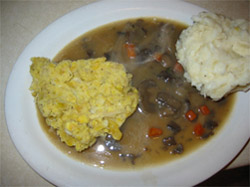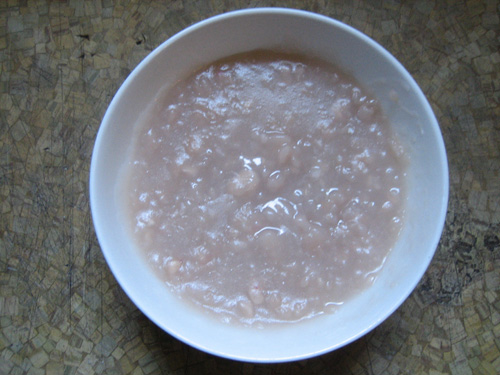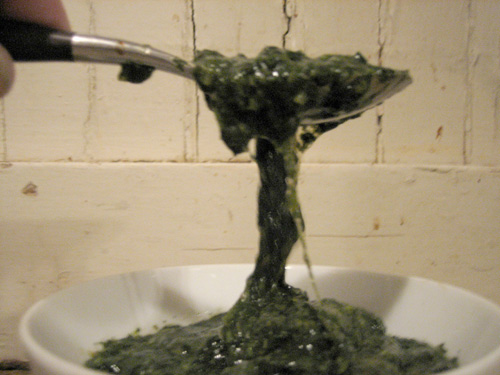From the Bollard.com
March 21, 2007
Off the Eatin' Path
By Zachary Barowitz
 |
Mashed plantain (left) and mashed cassava, with canned cream of mushroom soup. (photos/Zachary Barowitz) |
Fufu Frenzy!
Tired of rotating pasta, rice and potatoes? Looking for something instead of Stove Top® stuffing? Fufu is a great substitute – but who has time to mash yuca after a hard day?
Fufu flour is basically West African instant mashed potatoes, but softer, stickier, and made from dense cassava yam (also known as yuca and manioc), which is the ingredient in tapioca.
Instant fufu comes in different varieties – Cassava, Plaintain, Cocoyam – but they all contain cassava powder and all taste nearly the same. A cup of the flour is mixed into two cups of boiled water and stirred vigorously till smooth (less than a minute).
This is how I have always seen it made, but a Ghanaian friend once told me the fresh variety is healthier, because "when the woman mashes the yam, she imparts energy into it." This sounds suspiciously like a way to impart the virtues of manual labor onto women; nevertheless, real foods are generally healthier than instant ones.
Proper fufu is made from non-export, "bitter" grade yuca (not to be confused with yucca, the southwestern shrub), which has a higher cyanide content than the "sweet" grade available here. (Fear not: Many plants around the world produce toxins to repel pests; that's why herbs impart strong flavors and why citrus, when concentrated, cleans so well.) To make cassava edible, it is peeled, grated, soaked, pressed, fermented, pounded, and boiled or toasted, to be made into flour.
  |
"Real" fufu (left) and the instant mix variety. |
"Real" cassava – ground, frozen, and ready to cook – is available at Mitpheap Market on Washington Avenue. To prepare it, I cut the corner of the bag and squeeze it (like a pastry tube) to drop little balls into boiling water (it cooks in about five minutes). The fermentation makes it taste like sourdough dumplings.
Unlike mashed potatoes, fufu is elastic and nearly waterproof. Those willing to go native can eat it with your fingers (note: for sanitary reasons, only the right hand is used in the dining room). Break off a small clump, indent with your thumb, and use this semi-flattened piece to scoop up stew.
The "sweet" export variety tastes like a starchy potato, and can be eaten without first being detoxified. It can be used instead of potatoes, but fried cassava should be first boiled.
Fufu is gluten-free (celiacs, rejoice!), and lends itself to a number of intercultural applications, such as…
Mashed manioc
Making fufu from scratch is not as laborious as I thought it might be: a bit more work than real mashed potatoes. Peel the yucca with a sharp knife. Remove not only the wax-coated, brown outer-skin, but also the pinkish under-skin, then cut into chunks and boil until soft. After draining the water, remove any stringy bits (from the core and the ends) and then mince before pounding with a wooden pestle or a potato masher. Squishing the fufu with the back of a wooden spoon against the side of a bowl gives it a creamy texture.
Polenta-style fufu fritters
Form leftover fufu into a ball and let it cool in the fridge. Slice thick (1/2 inch) discs from the cold fufu ball and fry in oil over medium/high heat until golden. Depending on the moisture content of your fufu ball, the fritters may be firm or soft. Season with salt. Or bake slices and top with cheese.
Tostone-style plantain fufu fritters
Tostones are plantains cut on the bias that have been fried on medium/low heat, then cooled, squashed, and refried on a high flame. Form plantain fufu into a thick banana shape before slicing.
Mofongo
The Puerto Rican dish mofongo is a mound of mashed tostones with bits of crisp, fried meat (like bacon, chitlins, or chicken meat and skin) and fried garlic, served with a thick gravy, or in soup.
Fufu white sauce
Sprinkle instant fufu into hot milk and butter seasoned with salt, pepper and paprika. Good on frozen vegetables.
 |
Dessert is served: Fufu rice pudding. |
Fufu rice pudding
Slowly stir in one part fufu flour to four parts water. Smooth out the big clumps and continue to stir over a low heat until thick and gooey (about five minutes). Mix in sugar. The small clumps will absorb water and take on a rice texture. Can be eaten hot or chilled.
Palaver Sauce
If you are interested in moving up the plant, African markets also sell frozen, chopped cassava leaves. I made the mistake of trying to prepare this like spinach. The stringy fibers are meant to be slow-cooked in a so-called Palaver "sauce" with meat, dried fish, and ground egusi seeds; this "sauce" also has tomatoes, fresh fish, and okra as a thickener. Prepared otherwise, it is like eating mowed grass.
Egyptian molokhia (or jute leaves) is more mucilaginous (slimy) than okra, and could be added to the dish above instead, but is more typically eaten on its own. Collard greens or kale can be substituted, as well, but the quantities should be greater because they cook faster than cassava leaves – figure about 2-3 packages of frozen kale or their fresh equivalent. As with most stew recipes, the ingredients are flexible, and no ingredient is essential, although the greens are characteristic here.
A West African stew
West African stews tend to be heavier, often fortified with bright red palm oil (colored with annatto – the same stuff that makes yellow cheddar yellow). I use chopped yams to add sweetness and thickness. Dried shrimp enriches the broth and retains enough flavor that every bite is "meaty." The key is to not over-stir while cooking, so as to allow the onions to caramelize. For this reason, it is cooked relatively dry, with most of the moisture coming from the vegetables. I use the pot lid (on, off, partially on) to regulate the moisture.
 |
Molokhia – gesundheit! |
2 Tsp of olive oil or peanut oil
2 lbs of stew meat (beef, lamb, goat, sliced turkey legs, TVP)
2-3 large Spanish onions – chopped
3 smoked herring filets (available at La Bodega Latina and Harbor Fish Market)
1/3 cup of dried shrimp (available at Asian markets)
cayenne or other hot pepper
spices (like clove, nutmeg, ginger or coriander)
1 package of cassava leaves or 2-3 packages of frozen kale or collards or their fresh equivalent
1 large yam or sweet potato, cut in small cubes
1 cup okra, chopped
1 can of stewed whole tomatoes (drained, reserve the juice)
1 can of fish (tuna, sardines, salmon, or even mackerel)
2-3 tablespoons of peanut butter or ground egusi seeds or ground pumpkin seeds
1-2 Tsp Sesame oil (optional)
Sear the meat in hot oil. Add about 1/3 of a cup of water to deglaze the pan and then reduce and simmer to soften the meat. When the pot is almost dry, add the onions, greens, sweet potato, smoked herring, dried shrimp, hot pepper and a sprinkle of spices (do not stir). Reduce heat and cover until the vegetables form a thick sauce and the meat is tender (about 20 minutes). Stir in the okra and tomatoes, crush the tomatoes with your spoon and add the juice if the stew is dry. Cook about 20-30 minutes, stirring occasionally. Stir in the peanut butter or ground seeds, canned fish and sesame oil. If the stew is too dry, add broth; if too wet, sprinkle a little fufu flour.
Where to get fufu
Most of the African markets in town stock instant fufu, although none of the people I spoke with in the shops said they'd ever tried it. Here are a few places where you'll find the real thing…
• Halal Discount Market 44 Washington Ave., Portland.
Best selection of African foods and dry goods in town – and like the name says, good prices.
• Mitpheap Market 61 Washington Ave., Portland.
Primarily a Southeast Asian market, but also has a good selection of African and South American products. This is the only place where I saw frozen ground fufu.
• African Grocery 803 Congress St., Portland.
Located in the space last occupied by Youngo's coffee shop, this new grocery sells fufu, frozen cassava leaves, molokhia, and more. A nice, clean store, but their prices are a bit higher.